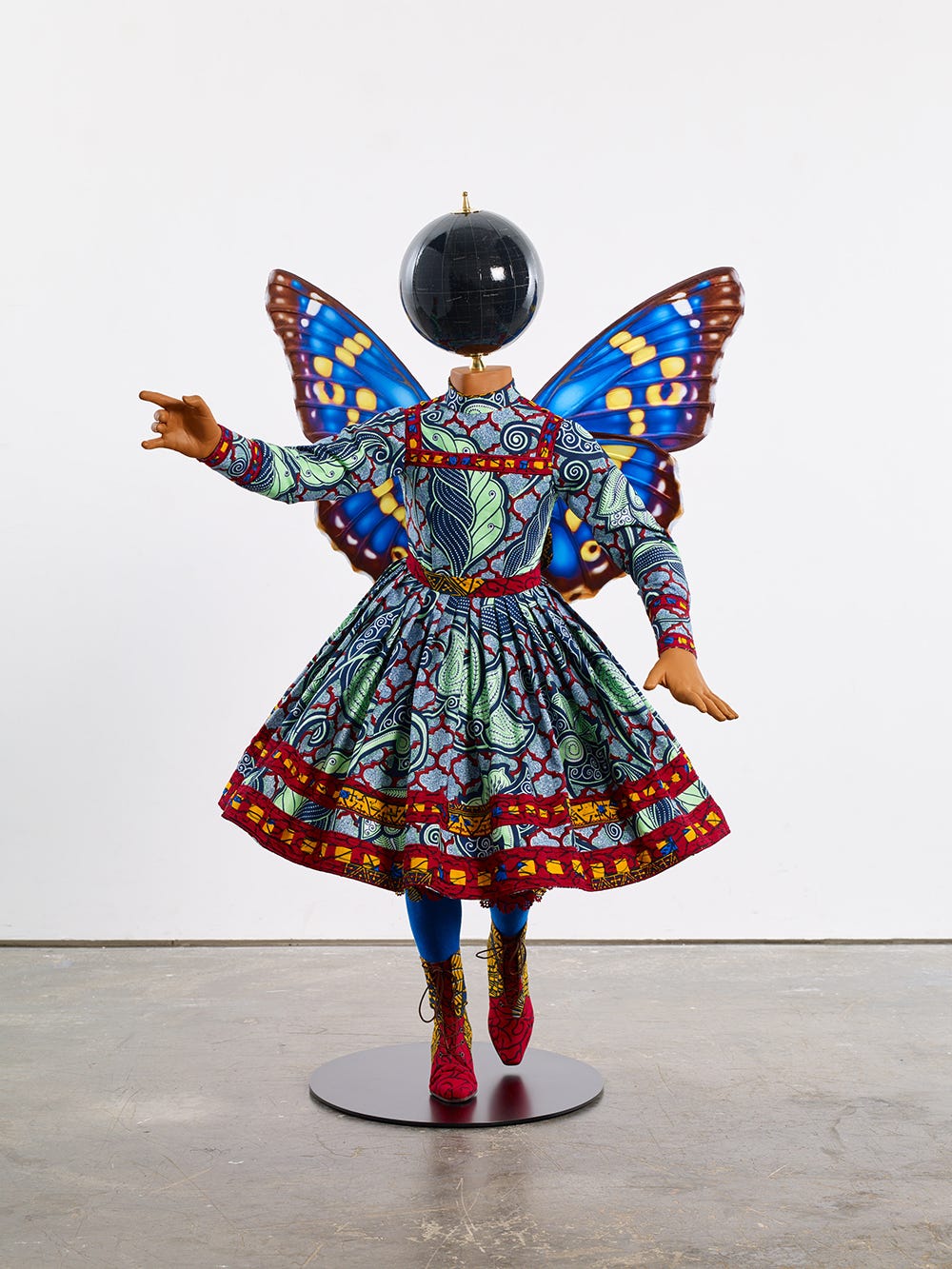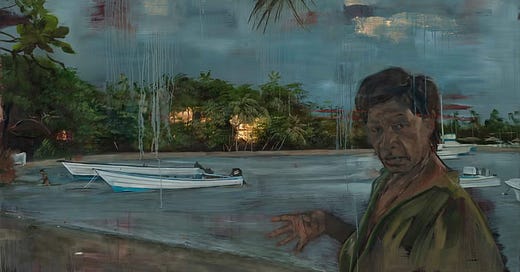🔅 Africa's Diaspora Is “Coming Home” for a Creative Boom
And Why Are So Many Maids Dying in Saudi Arabia?

Good morning from… Can you guess where in Africa this is? (Answer at the bottom!)
How the African Diaspora Is “Coming Home” for a New Creative Boom
London-based painter Emma Prempeh, brushes in hand, landed in Ghana for the first time in ages – this time not just to play tourist, but to mount a legit solo show at Accra’s ADA Contemporary Art Gallery. It’s her father’s homeland, and she had that I’m-seeking-my-roots moment that, let’s face it, many diaspora kids daydream about. Fast-forward a few months, and she’s also popping up in Cameroon, Nigeria, and even rummaging through her mother’s Caribbean heritage. And she’s not alone.
Turns out, Africa is now brimming with these “long-lost” stars of the art world – folks who grew up in London or New York or Brussels but still have Ghanaian, Nigerian, or even Ethiopian roots. Yinka Shonibare, the iconic British-Nigerian artist, unleashed a major show in Lagos a while back. Amoako Boafo, raised in Ghana and based in Vienna, keeps cameoing at Accra’s Gallery 1957. There’s an army of others: big names, up-and-comers, all hustling their way back to various corners of the continent.

So, why the diaspora deluge? Ask any of them, and you’ll get a swirl of answers: From “I want to show my father I'm legit” to “the local audience just gets me” or “my maternal grandmother was from this village, you see.”
And guess what? African galleries are here for it. Their owners, like Tiwani Contemporary’s Maria Varnava, glow with excitement whenever a diaspora phenom steps off the plane. “It’s all about building collector networks on the continent,” they say. Indeed, it’s not just about finding emotional ties or fulfilling genealogical fantasies – it’s also (forgive the cynicism) about tapping newly minted local collectors who are more than happy to see their own cultural reflection on the canvas.
In turn, the diaspora are discovering that Africa’s not the “gallery desert” it was once stereotyped as. In fact, quite the opposite – big brand galleries, curated shows, and a blossoming scene that’s no longer overshadowed by European capitals. These artists are hooking up residences from Accra to Douala, forging relationships with local crafters, reuniting with extended families, and blending all that cultural swirl into canvases. The work? Full of color, tradition, hybrid identity, you name it.
So if you see an art star on your next flight to Ghana, Nigeria, or Morocco, you can guess what they’re up to: stepping onto the runway of belonging. It’s a cross-continental trifecta of personal identity, commercial savvy, and a brand-new wave of diaspora-led curation. Or, you might say, it’s the ultimate “family reunion” for the art world.
Why So Many Maids Keep Dying in Saudi Arabia

Hundreds of thousands of women from Kenya and Uganda flock to Saudi Arabia each year, dreaming of better pay as housekeepers or nannies. They snap selfies in matching T-shirts at the Nairobi or Kampala airports, excited by the recruiters’ promise: “Work two years, earn enough to build a house.” But on the arrivals end, there’s a grim story – dozens come back in coffins or with horrifying accounts of being starved, beaten, raped, or left unpaid, as per The New York Times.
Everyone in power seems to have a finger in the pie: Kenyan politicians who also own staffing agencies, Saudi royals and elites who invest in mega–recruitment firms, even well-connected relatives of African presidents who run these “maid-for-export” businesses. These are the people who could clamp down on rights abuses, but conflict of interest is a huge obstacle. They’d be effectively policing themselves.
Officially, there are rules that ban confiscating passports or skipping wages once these young ladies make it across. In reality, that’s exactly what many families report. If you try to quit, you become “illegal,” sometimes landing in a locked “shelter” – more prison than safe haven – or forced to pay for your flight home. Some women have been found dead under mysterious circumstances. Saudi authorities label them “natural deaths” even when autopsies show shock marks, broken ribs, or signs of electrocution.
Politicians in Kenya and Uganda hype Saudi jobs to plug budget holes through remittances. In fairness, the money from these women’s wages is a big chunk of national income. But negotiations over wages or worker protections? They’re lackluster. The Philippines demanded a higher salary floor for its workers and got it. Kenya tried. Saudi balked. Kenya caved. End of story.
And so, amid the optimism of so many would-be migrants lined up at the airport, there’s a sobering undercurrent: they join a pipeline that’s systemically unsafe. While multiple governments champion this “we’re shipping folks abroad” strategy for an economic boost, the reality is an underbelly of exploitation and abuse. Many arrive home in caskets, with no one in power taking genuine responsibility.
Has Africa’s Great Green Wall Finally Found Its Groove?

For years, the Sahel’s much-hyped “Great Green Wall”—an 8,000-kilometer mosaic of forests, farms, and grasslands intended to halt desertification—was stuck in limbo, bogged down by weak funding and vexing local conflicts. But guess what? The project seems to be coming back with a vengeance, courtesy of a new accelerator program that’s pouring billions of dollars into reversing decades of deforestation and land degradation.
First, a quick refresher: The Great Green Wall, launched by the African Union in 2007, aims to reforest 100 million hectares across the Sahel, create millions of jobs, and lock up 250 million metric tons of carbon by 2030. Ambitious, right? Except as of 2020, it had restored just 18 million hectares and created 350,000 jobs—far short of its lofty targets.
A 2020 United Nations (UNCCD) report revealed the initiative was starved of coordination and badly lacking in metrics—no one quite knew how to measure or track the project. That frank assessment led to an accelerator program in 2021, complete with an extra $19 billion promised. Now, brand-new national coalitions in each of the 11 Sahel countries are gathering data on everything from tree planting to local job creation.
To keep all those scattered efforts in sync, the UNCCD whipped up an online dashboard called the Great Green Wall Observatory. It’s a one-stop shop for donors, project managers, and starry-eyed environmentalists who want to see who’s planting what, where, and how. Some data are still missing, and it’s not exactly the slickest website you’ve ever seen, but it’s the first time the Great Green Wall has had a consistent scoreboard.
Still, Obstacles Remain: All that new enthusiasm doesn’t magically solve persistent woes. The folks who do the grunt work—civil society groups—struggle to tap those giant donor checks. Worse, violent conflict in the Sahel complicates matters, and climate pressures loom. Yet groups like SOS Sahel and Tree Aid keep forging ahead, replanting woodlands, championing local ownership, and even dabbling in carbon markets to fund large-scale reforestation.
But optimists point out there are now more than 300 tracked projects, and those newly minted national coalitions are finally talking to each other. Could the Great Green Wall actually make it? People like Gilles Ouédraogo at the UNCCD seem confident. He’s envisioning a day when you can pull up the dashboard and see, in real time, how each freshly restored hectare not only sequesters carbon but also supports communities.
Skeptical? Sure—no one says it’ll be easy. But watchers say the momentum is real. If the money stays in the pipeline and local communities remain the centerpiece, the Sahel’s once-stalled “Wall” might just blossom for good. And for a region that’s seen its fair share of disappointment, that would be a breath of fresh desert air.
Food for Thought
“The tongue forgets more than the ear.”
— Uganda Proverb
And the Answer is…
The photo is from Gabon! Did you guess right?
You can also send in your own photos of Africa, alongside the location, and we’ll do our best to feature them.





It’s the ultimate “family reunion”!